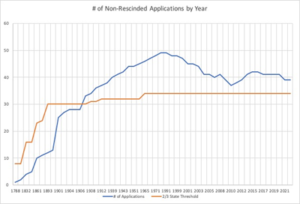 By Judi Caler
By Judi Caler
December 2, 2022
Part 1: Validation Schemes
Sound the alarm!! We are closer than ever before in our nation’s history to Congress’s calling a convention under Article V of the US Constitution, where we would likely lose our Constitution. And it’s because of yet another deception from the con-con lobby.
Article V says that “The Congress…on the Application of the Legislatures of two thirds of the several States [now 34], shall call a Convention for proposing Amendments [to the US Constitution]…”
There have been approximately 450 applications passed by 49 State Legislatures since 1788, the year our Constitution was ratified. So, whether or not a constitutional convention has been triggered depends upon the criteria Congress uses to determine which of the 450 applications are valid. Only then can Congress count the States that submitted those applications to find out whether or not the 34-state threshold was reached.
On July 19, 2022, US Rep. Jodey Arrington (R-TX), introduced H.Con.Res.101 and H.R.8419. The former is a purported “call” for a convention.[1] And the latter directs the Archivist of the United States to “authenticate, count, and publish” all non-rescinded applications and notify Congress of its duty to call a convention, if those applications were passed by at least 34 State Legislatures.
Of the 450 applications passed since 1788, about 230 have since been rescinded[2]—leaving about 220 non-rescinded applications from 39 States. So, if H.R.8419 becomes law, Congress will all but guarantee that the first constitutional convention since 1787 will be triggered—simply by establishing “all non-rescinded applications” as the only criterion by which Congress would authenticate applications!
H.R.8419—A Validation Scheme Too Big to Fail
Although counting states from the set of “non-rescinded applications” seems reasonable on its surface, it’s a trick. Every application passed since the 18th century that states hadn’t bothered to rescind would be considered valid under H.R.8419 (or an updated 2023 bill #). And almost 80% percent of those “valid” applications were passed before the 21st Century.
Rep. Arrington would combine all relatively recent applications with applications passed by at least 24 State Legislatures asking Congress to call a convention to propose amendments on obsolete topics, including directly electing US Senators (resolved by the 17th Amendment ratified  in 1913); averting the Civil War (ended in 1865); prohibiting polygamy (now outlawed in all 50 states), repealing prohibition (resolved by the 21st Amendment ratified in 1933), prohibiting slavery (resolved by the 13th Amendment ratified in 1865), averting the Nullification Crisis of 1832–33, and adding a Bill of Rights to our Constitution (ratified in 1791).
in 1913); averting the Civil War (ended in 1865); prohibiting polygamy (now outlawed in all 50 states), repealing prohibition (resolved by the 21st Amendment ratified in 1933), prohibiting slavery (resolved by the 13th Amendment ratified in 1865), averting the Nullification Crisis of 1832–33, and adding a Bill of Rights to our Constitution (ratified in 1791).
In fact, we hit the 2/3-state threshold for Congress’s calling a convention per H.R.8419 in…(drumroll)… 1907, and we’ve NEVER dropped below the threshold in the 115 years since! The number of states with non-rescinded applications gradually grew from 34 states in 1908 to 48 & 49 States during the 3 decades between 1970 and 2000; and stands at 39 states today due to rescissions. That’s more than enough States to trigger a convention. (See graph).
Raise your hand if you think the Framers envisioned giving the states centuries in which to reach the 34-state threshold—so that by the time Congress called a convention, the American People would no longer remember or care about the issues that triggered the call!
Common Sense Validations
There are common sense ways for Congress to validate applications that would yield markedly different results than H.R.8419. In addition to considering all rescinded applications invalid, Congress could add the following criteria:
Validation by Obsolescence. Common sense dictates that if the purpose for calling the convention has been resolved (i.e. the Civil War, etc.), the applications should automatically expire.
Validation by Age. If a crisis could be remedied by altering or overhauling our founding document, then 34 States should be able to pass applications within, say, a five-year timeframe.[3] Consider that 46 States enacted COVID-19 legislation within just 10 months in 2020; and all 50 States did so within the 2021 calendar year.[4]
Validation by Type (limited or unlimited). Yale law professor Charles L. Black Jr. (1915–2001) was one of the leading constitutional law scholars of the twentieth century. Black considered all applications asking Congress to call a convention limited by subject, null & void—and that would include most of the applications passed by State Legislatures in the last 45 years. Other scholars agree[5]:
“I believe that, in Article V, the words ‘a Convention for proposing Amendments’ mean ‘a convention for proposing such amendments as that convention decides to propose…’[thus] a State application for a convention limited to one or more proposals or subjects is not an application for the ‘Convention’ denoted by the words in Article V…
“…[I]f thirty-four States may put Congress under a certain obligation by, and only by, requesting X, and thirty-four States request Y instead, then no congressional obligation arises6. —Charles L. Black, “Amending the Constitution: A Letter to a Congressman”
Depending upon which criteria Congress chooses, there are currently valid applications submitted to Congress from NO states, 39 states, or somewhere in between! Change the criteria, and you’ll change the result.
The Convention Deception
Mark Meckler, President of “Convention of States (COS),” and the other special-interest lobbyists have been falsely assuring legislators for nearly a decade, that a “runaway convention” is next to impossible. That’s because, they say, only when Congress receives 34 identical or similar applications on the same subject or subjects can Congress call a convention; and, they say, that convention would be limited to the subject of the 34 applications.
But the proponents’ own Article V experts contradict their lobbyists! Attorney and Article V scholar John Cogswell, who admittedly bends over backwards to ensure Congress’s calling a convention, made the following points in a 2018 report to the American Constitution Foundation (ACF)7:
“Congress has a duty to call a convention for proposing amendments without any limitations on the agenda of the convention…” p. 2
“There is no such thing as a ‘limited’ constitutional convention because a convention by definition and practice is a free agency and may propose whatever it likes…” p. 18
“…a convention for amendments could easily amend the Constitution in its entirety and replace it with some other document…” p. 27
“…it is unanimously understood by all scholars that the rules of the convention are to be decided by the convention.” p. 28.
Proponents bury the “too-big-to-fail” validation scheme in one bland adjective—“non-rescinded”—in §106c(b) under §1(a) of H.R.8419 and in §1(a)(2)(A) of H.Con.Res.101. But the accompanying press release, including legislative summaries and comments by Rep. Arrington pretend to promote a “Fiscal Responsibility Amendment” and “Article V Accountability.”
H.R.8419 & H.Con.Res.101 are in-your-face evidence that proponents are attempting to manipulate the 34-state count to trick Congress into calling a convention which is inherently illimitable. This is not surprising, coming from the same folks that misled State Legislatures into passing applications for a “limited” convention.
Coming soon: Part 2
© 2022 Judi Caler – All Rights Reserved
E-Mail Judi Caler: judicaler@hotmail.com
Footnotes:
[1] But since applications from 34 States need to be authenticated before Congress calls a convention, H.Con.Res.101 appears to defy the Constitution.
[2] Compiled from applications posted on the unofficial Article V Library website, corrected for Illinois’ 2022 rescission.
[3] Only 10 States passed applications in the past 5 legislative years (2018–2022).
[4] Select Year (2020 or 2021); and Status: “Enacted” within the COVID-19 Database.
[5] For example, convention proponents John Cogswell and Michael Stokes Paulsen. See Cogswell’s 2018 ACF Report.
[6] Yale Law Journal, 199 1972–1973
[7] ACF’s goal is to facilitate a “general” convention, where no amendment is declared off-limits in advance by language in the applications. In 2018, John Cogswell conducted a study for ACF and found valid applications from 36 States.




